Mapping Decomposition: A Preliminary Study of Non-Destructive Detection of Simulated body Fluids in the Shallow Subsurface
Abstract
:1. Introduction
2. Materials and Methods
3. Results and Discussion
3.1. GPR Results
3.2. Satellite Imagery Using NDVI
3.3. Drone Imagery Using VARI
3.4. Limitations and Future Perspectives
4. Conclusions
Author Contributions
Funding
Informed Consent Statement
Conflicts of Interest
References
- Elmes, G.A.; Roedl, G.; Conley, J. (Eds.) Forensic GIS: The Role of Geospatial Technologies for Investigating Crime and Providing Evidence; Geotechnologies and the Environment; Springer: Dordrecht, The Netherlands, 2014; ISBN 978-94-017-8756-7. [Google Scholar]
- Avery, T.E. Fundamentals of Remote Sensing and Airphoto Interpretation/Thomas Eugene Avery, Graydon Lennis Berlin, 15th ed.; Prentice Hall: Upper Saddle River, NJ, USA, 1992; ISBN 978-0-02-305035-0. [Google Scholar]
- Hodge, S. Satellite Data and Environmental Law: Technology Ripe for Litigation Application. Pace Environ. Law Rev. 1997, 14, 691. [Google Scholar]
- Barone, P.; Di Maggio, R.M. Low-Cost CSI Using Forensic GPR, 3D Reconstruction, and GIS. J. Geogr. Inf. Syst. 2019, 11, 493–499. [Google Scholar] [CrossRef]
- Rocke, B.; Ruffell, A. Detection of Single Burials Using Multispectral Drone Data: Three Case Studies. Forensic Sci. 2022, 2, 6. [Google Scholar] [CrossRef]
- Pensieri, M.G.; Garau, M.; Barone, P.M. Drones as an Integral Part of Remote Sensing Technologies to Help Missing People. Drones 2020, 4, 15. [Google Scholar] [CrossRef]
- Rocke, B.; Ruffell, A.; Donnelly, L. Drone Aerial Imagery for the Simulation of a Neonate Burial Based on the Geoforensic Search Strategy (GSS). J. Forensic Sci. 2021, 66, 1506–1519. [Google Scholar] [CrossRef]
- Hildmann, H.; Kovacs, E. Review: Using Unmanned Aerial Vehicles (UAVs) as Mobile Sensing Platforms (MSPs) for Disaster Response, Civil Security and Public Safety. Drones 2019, 3, 59. [Google Scholar] [CrossRef]
- Barone, P.M. Understanding Buried Anomalies: A Practical Guide to GPR; LAP LAMBERT Academic Publishing: Saarbrücken, Germany, 2016. [Google Scholar]
- Barone, P.M. Forensic Geophysics. In Geoscientists at Crime Scenes: A Companion to Forensic Geoscience; Di Maggio, R.M., Barone, P.M., Eds.; Soil Forensics; Springer International Publishing: Cham, Germany, 2017; pp. 175–190. ISBN 978-3-319-58048-7. [Google Scholar]
- Ruffell, A.; McKinley, J. Geoforensics|Wiley. Available online: https://www.wiley.com/en-us/Geoforensics-p-9780470057353 (accessed on 24 June 2022).
- Schultz, J.J. Using Ground-Penetrating Radar to Locate Clandestine Graves of Homicide Victims: Forming Forensic Archaeology Partnerships With Law Enforcement. Homicide Stud. 2007, 11, 15–29. [Google Scholar] [CrossRef]
- Leblanc, G.; Kalacska, M.; Soffer, R. Detection of Single Graves by Airborne Hyperspectral Imaging. Forensic Sci. Int. 2014, 245, 17–23. [Google Scholar] [CrossRef]
- Parrott, E.; Panter, H.; Morrissey, J.; Bezombes, F. A Low Cost Approach to Disturbed Soil Detection Using Low Altitude Digital Imagery from an Unmanned Aerial Vehicle. Drones 2019, 3, 50. [Google Scholar] [CrossRef]
- Wueste, E.; Facchin, G.; Barone, P.M. Aventinus Minor Project: Remote Sensing for Archaeological Research in Rome (Italy). Remote Sens. 2022, 14, 959. [Google Scholar] [CrossRef]
- Meeragandhi, G.; Arun, S.P.; Thummala, N.; Christy, A. Ndvi: Vegetation Change Detection Using Remote Sensing and Gis—A Case Study of Vellore District. Procedia Comput. Sci. 2015, 57, 1199–1210. [Google Scholar] [CrossRef] [Green Version]
- Makario, S. Normalized Difference Vegetation Index (NDVI) in Remote Sensing. Available online: https://blog.heptanalytics.com/normalized-difference-vegetation-indexndvi-in-remote-sensing/ (accessed on 24 June 2022).
- Weier, J.; Herring, D. Measuring Vegetation (NDVI & EVI). Available online: https://earthobservatory.nasa.gov/features/MeasuringVegetation (accessed on 9 November 2021).
- Brown, J. NDVI, the Foundation for Remote Sensing Phenology|U.S. Geological Survey. Available online: https://www.usgs.gov/special-topics/remote-sensing-phenology/science/ndvi-foundation-remote-sensing-phenology?msclkid=0601ef9faf6611ecafe6714da26ff426 (accessed on 24 June 2022).
- Lasaponara, R.; Masini, N. Identification of Archaeological Buried Remains Based on the Normalized Difference Vegetation Index (NDVI) from QuickBird Satellite Data. Geosci. Remote Sens. Lett. IEEE 2006, 3, 325–328. [Google Scholar] [CrossRef]
- Donnelly, L.; Harrison, M. Geomorphological and Geoforensic Interpretation of Maps, Aerial Imagery, Conditions of Diggability and the Colour-Coded RAG Prioritization System in Searches for Criminal Burials. Geol. Soc. Lond. Spec. Publ. 2013, 384, 173–194. [Google Scholar] [CrossRef]
- Donnelly, L.; Harrison, M. Geoforensic search strategy (GSS): Ground searches related to homicide graves, counterterrorism and serious crime. In A guide to Forensic Geology; Donnelly, L.J., Pirrie, D., Harrison, M., Ruffell, A., Dawson, L., Eds.; Geological Society: London, UK, 2021; pp. 21–85. [Google Scholar] [CrossRef]
- Harrison, M.; Donnelly, L.J. Locating Concealed Homicide Victims: Developing the Role of Geoforensics. In Criminal and Environmental Soil Forensics; Ritz, K., Dawson, L., Miller, D., Eds.; Springer: Dordrecht, The Netherlands, 2009; pp. 197–219. ISBN 978-1-4020-9204-6. [Google Scholar]
- Lindsey, A.J.; Craft, J.C.; Barker, D.J. Modeling Canopy Senescence to Calculate Soybean Maturity Date Using NDVI. Crop Sci. 2020, 60, 172–180. [Google Scholar] [CrossRef]
- Limongiello, M.; Gujski, L.; De Vita, C. Analysis of RGB Images to Enhance Archaeological Cropmark Detection: The Case Study of Nuceriola, Italy. In Proceedings of the 42th International Conference of Representation Disciplines Teachers Congress of Unione Italiana per il Disegno; Franco Angeli: Milan, Italy, 2020; pp. 2360–2368. [Google Scholar] [CrossRef]
- Ronchi, D.; Limongiello, M.; Barba, S. Correlation among Earthwork and Cropmark Anomalies within Archaeological Landscape Investigation by Using LiDAR and Multispectral Technologies from UAV. Drones 2020, 4, 72. [Google Scholar] [CrossRef]
- Pringle, J.K.; Stimpson, I.G.; Wisniewski, K.D.; Heaton, V.; Davenward, B.; Mirosch, N.; Spencer, F.; Jervis, J.R. Geophysical Monitoring of Simulated Clandestine Burials of Murder Victims to Aid Forensic Investigators. Geol. Today 2021, 37, 63–65. [Google Scholar] [CrossRef]
- Pringle, J.K.; Jervis, J.; Cassella, J.P.; Cassidy, N.J. Time-Lapse Geophysical Investigations over a Simulated Urban Clandestine Grave. J. Forensic Sci. 2008, 53, 1405–1416. [Google Scholar] [CrossRef]
- Ruffell, A.; Mckinley, J.; Donnelly, L.; Harrison, M.; Keaney, A. Geoforensics, 1st ed.; John Wiley & Sons Inc: Chichester, UK; Hoboken, NJ, USA, 2008; ISBN 978-0-470-05735-3. [Google Scholar]
- Koppenjan, S.K.; Nevada, B.; Schultz, J.J.; Falsetti, A.B.; Collins, M.E.; Ono, S.; Lee, H. The Application of GPR in Florida for Detecting Forensic Burials. In Proceedings of the 16th EEGS Symposium on the Application of Geophysics to Engineering and Environmental Problems (SAGEEP), San Antonio, TX, USA, 6–10 April 2003; p. 190-00063. [Google Scholar] [CrossRef]
- Midi, N.S.; Sasaki, K.; Ohyama, R.; Shinyashiki, N. Broadband Complex Dielectric Constants of Water and Sodium Chloride Aqueous Solutions with Different DC Conductivities. IEEJ Trans. Electr. Electron. Eng. 2014, 9, S8–S12. [Google Scholar] [CrossRef]
- Persico, R. Introduction to Ground Penetrating Radar: Inverse Scattering and Data Processing; IEEE: Hoboken, NJ, USA, 2014; ISBN 978-1-118-30500-3. [Google Scholar]
- Jol, H.M. Ground Penetrating Radar Theory and Applications; Elsevier: Amsterdam, The Netherlands, 2009. [Google Scholar]
- Conyers, L.B. Ground-Penetrating Radar. In Encyclopedia of Geoarchaeology; Gilbert, A.S., Ed.; Springer: Dordrecht, The Netherlands, 2017; pp. 367–378. ISBN 978-1-4020-4409-0. [Google Scholar]
- Donnelly, L.J.; Pirrie, D.; Harrison, M.; Ruffell, A.; Dawson, L.A. The Geological Society of London—A Guide to Forensic Geology; GSL Miscellaneous Titles; GSL: London, UK, 2021; ISBN 978-1-78620-488-2. [Google Scholar]
- Barone, P.M.; Ferrara, C.; Pettinelli, E.; Fazzari, A. Forensic Geophysics: How the GPR Technique Can Help with Forensic Investigations. In Proceedings of the Soil in Criminal and Environmental Forensics; Kars, H., van den Eijkel, L., Eds.; Springer International Publishing: Cham, Switzerland, 2016; pp. 213–227. [Google Scholar]
- Barone, P.M.; Ferrara, C.; Pettinelli, E.; Annan, A.P.; Fazzari, A.; Redman, D. Forensic Geophysics: How GPR Could Help Police Investigations. In Proceedings of the Near Surface Geoscience 2012—18th European Meeting of Environmental and Engineering Geophysics; Paris, France, 3–5 September 2012, European Association of Geoscientists & Engineers: Houten, The Netherlands, 2012; p. 306-00001. [Google Scholar] [CrossRef]
- Barone, P.M.; Di Maggio, R.M. Forensic Geophysics: Ground Penetrating Radar (GPR) Techniques and Missing Persons Investigations. Forensic Sci. Res. 2019, 4, 337–340. [Google Scholar] [CrossRef]
- Solla, M.; Riveiro, B.; Álvarez Cid, M.; Arias, P. Experimental Forensic Scenes for the Characterization of Ground-Penetrating Radar Wave Response. Forensic Sci. Int. 2012, 220, 50–58. [Google Scholar] [CrossRef]
- Di Maggio, R.M.; Barone, P.M. (Eds.) Geoscientists at Crime Scenes: A Companion to Forensic Geoscience; Soil Forensics; Springer International Publishing: Berlin/Heidelberg, Germany, 2017; ISBN 978-3-319-58047-0. [Google Scholar]
- Collins, S.; Maestrini, L.; Ueland, M.; Stuart, B. A Preliminary Investigation to Determine the Suitability of Pigs as Human Analogues for Post-Mortem Lipid Analysis. Talanta Open 2022, 5, 100100. [Google Scholar] [CrossRef]
- DeBruyn, J.M.; Hoeland, K.M.; Taylor, L.S.; Stevens, J.D.; Moats, M.A.; Bandopadhyay, S.; Dearth, S.P.; Castro, H.F.; Hewitt, K.K.; Campagna, S.R.; et al. Comparative Decomposition of Humans and Pigs: Soil Biogeochemistry, Microbial Activity and Metabolomic Profiles. Front. Microbiol. 2021, 11, 608856. [Google Scholar] [CrossRef] [PubMed]
- Matuszewski, S.; Hall, M.J.R.; Moreau, G.; Schoenly, K.G.; Tarone, A.M.; Villet, M.H. Pigs vs People: The Use of Pigs as Analogues for Humans in Forensic Entomology and Taphonomy Research. Int. J. Legal Med. 2020, 134, 793–810. [Google Scholar] [CrossRef] [PubMed]
- Corwin, D.; Yemoto, K. Salinity: Electrical Conductivity and Total Dissolved Solids. Soil Sci. Soc. Am. J. 2020, 84, 1442–1461. [Google Scholar] [CrossRef]
- Gadani, D.; Rana, V.; Bhatnagar, S.; Prajapati, A.; Vyas, A.D. Effect of Salinity on the Dielectric Properties of Water. Indian J. Pure Appl. Phys. 2012, 50, 405–410. [Google Scholar]
- Klemetsen, Ø. Design and Evaluation of a Medical Microwave Radiometer for Observing Temperature Gradients Subcutaneously in the Human Body. Ph.D. Thesis, University of Tromsø, Tromsø, Norway, 2012. [Google Scholar]
- Andreuccetti, D.; Fossi, R.; Petrucci, C. An Internet Resource for the Calculation of the Dielectric Properties of Body Tissues in the Frequency Range 10 Hz–100 GHz. Available online: http://niremf.ifac.cnr.it/tissprop/ (accessed on 24 June 2022).
- Rusydi, A.F. Correlation between Conductivity and Total Dissolved Solid in Various Type of Water: A Review. IOP Conf. Ser. Earth Environ. Sci. 2018, 118, 012019. [Google Scholar] [CrossRef]
- Petrucci, R.H.; Harwood, W.S.; Herring, G. General Chemistry: Principles and Modern Applications, 11th ed.; Pearson: Toronto, ON, Canada, 2017. [Google Scholar]
- Hume, R.; Weyers, E. Relationship between Total Body Water and Surface Area in Normal and Obese Subjects. J. Clin. Pathol. 1971, 24, 234–238. [Google Scholar] [CrossRef]
- Watson, P.E.; Watson, I.D.; Batt, R.D. Total Body Water Volumes for Adult Males and Females Estimated from Simple Anthropometric Measurements. Am. J. Clin. Nutr. 1980, 33, 27–39. [Google Scholar] [CrossRef] [Green Version]
- Abate, D.; Sturdy Colls, C.; Moyssi, N.; Karsili, D.; Faka, M.; Anilir, A.; Manolis, S. Optimizing Search Strategies in Mass Grave Location through the Combination of Digital Technologies. Forensic Sci. Int. Synerg. 2019, 1, 95–107. [Google Scholar] [CrossRef]
- Cross, P.; Simmons, T.; Cunliffe, R.; Chatfield, L. Establishing a Taphonomic Research Facility in the United Kingdom. Forensic Sci. Policy Manag. Int. J. 2010, 1, 187–191. [Google Scholar] [CrossRef]
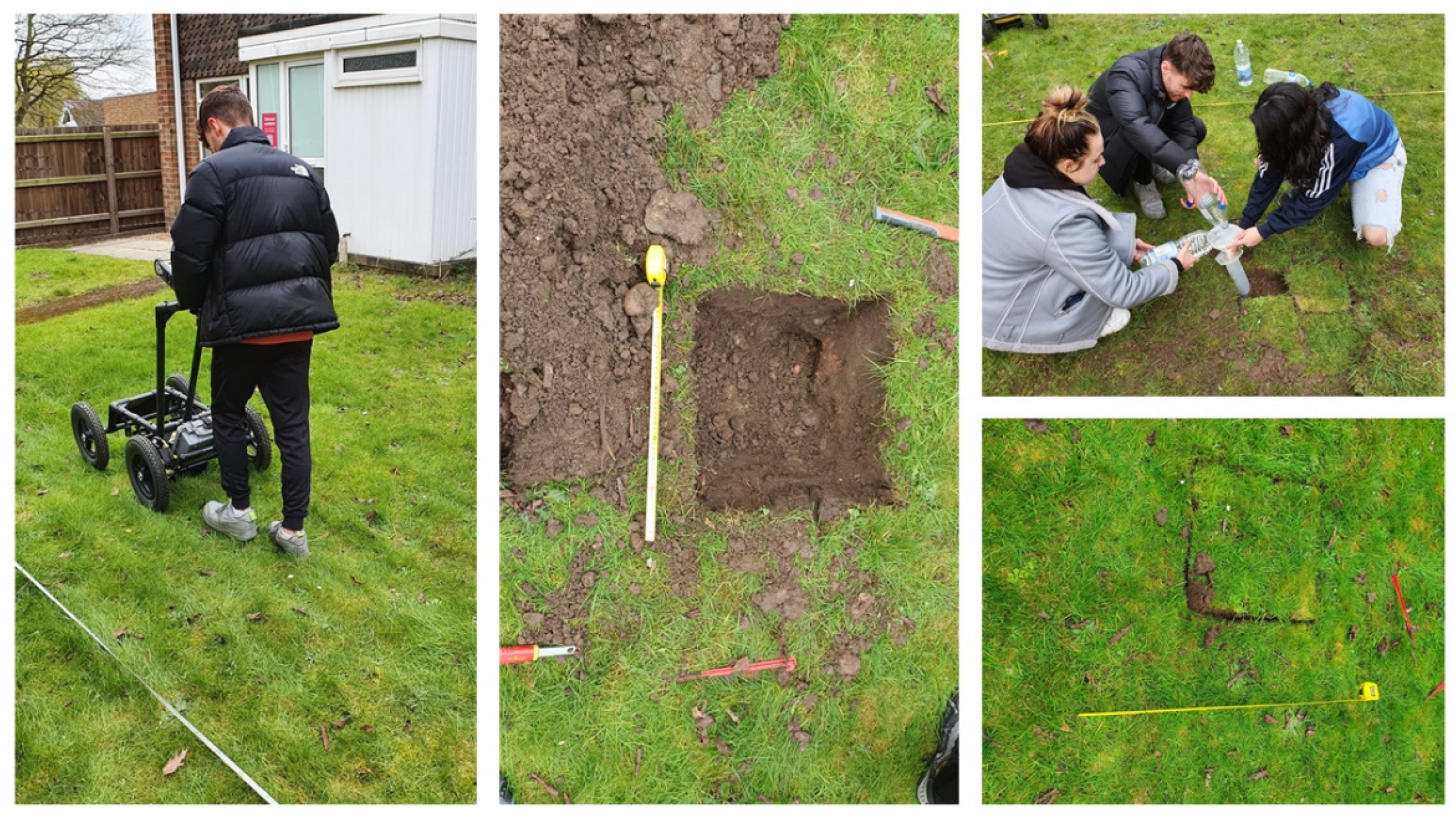

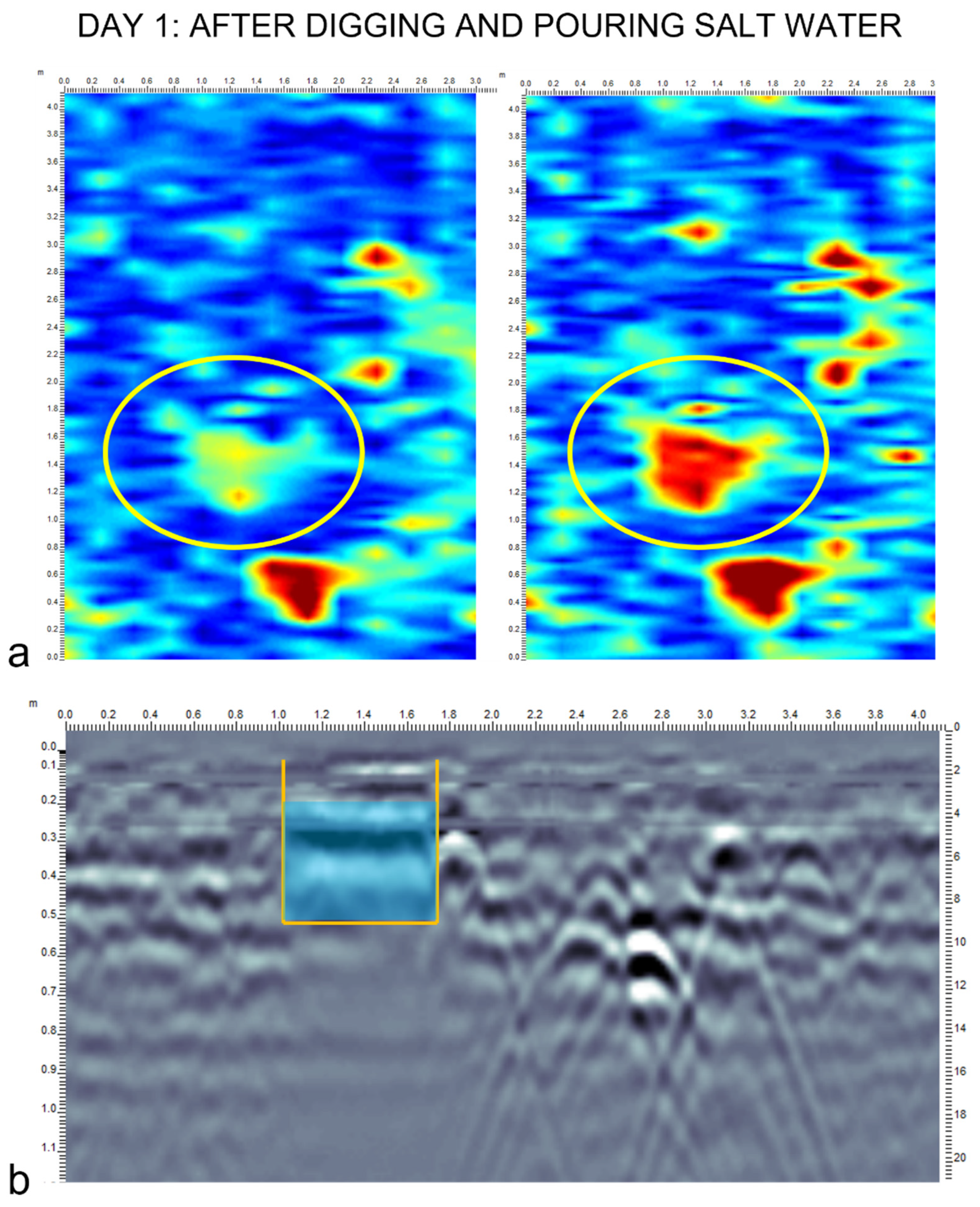
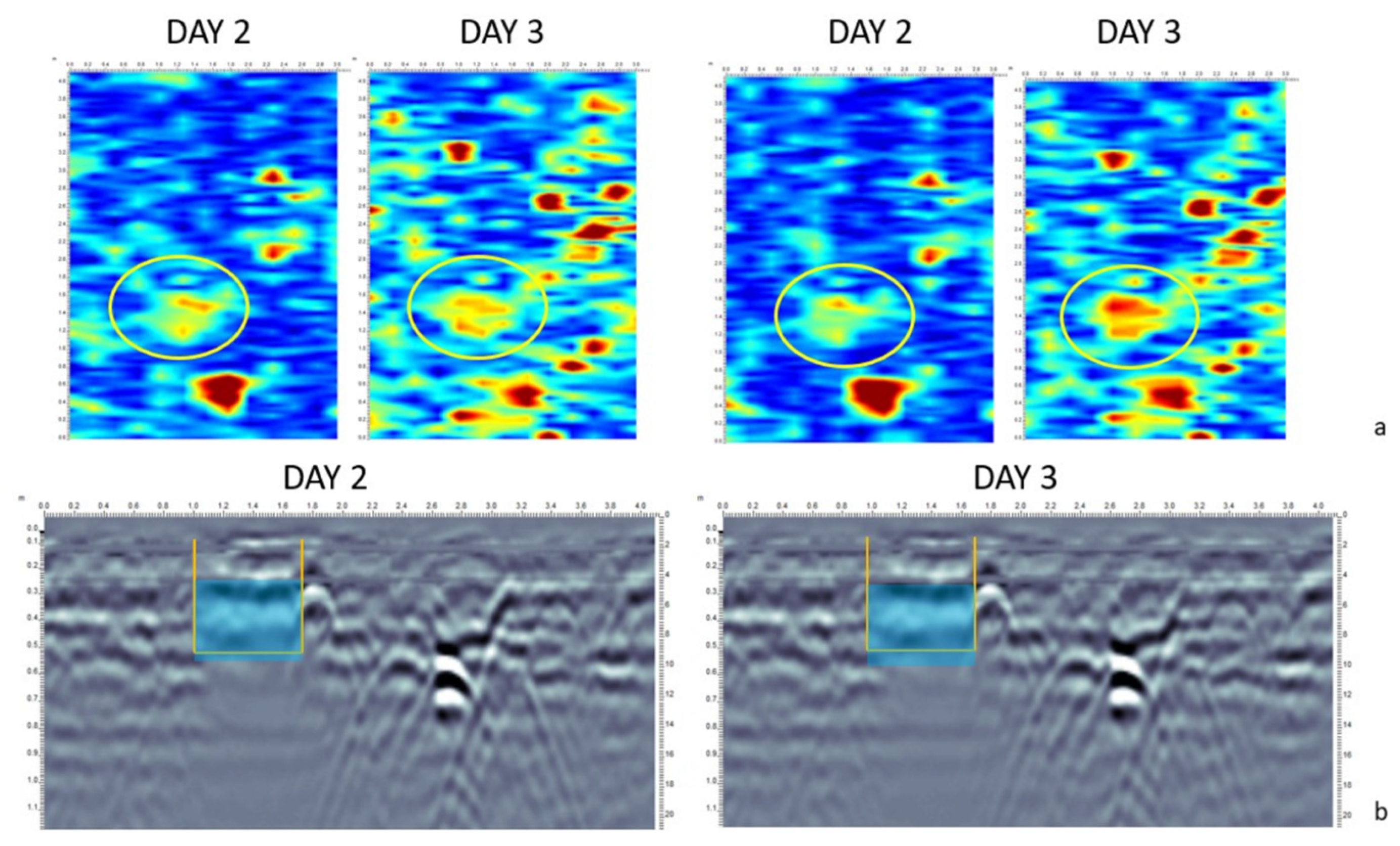
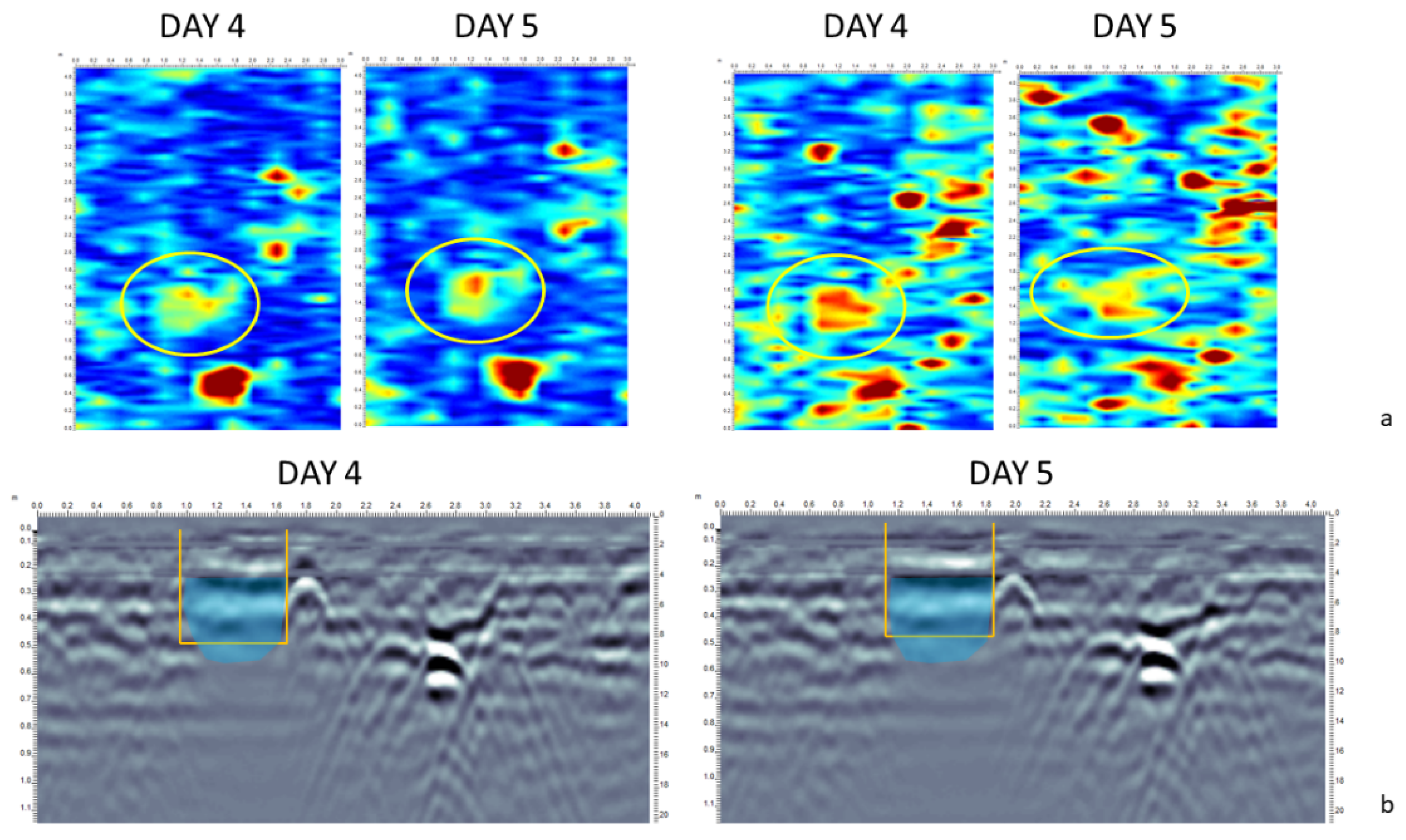
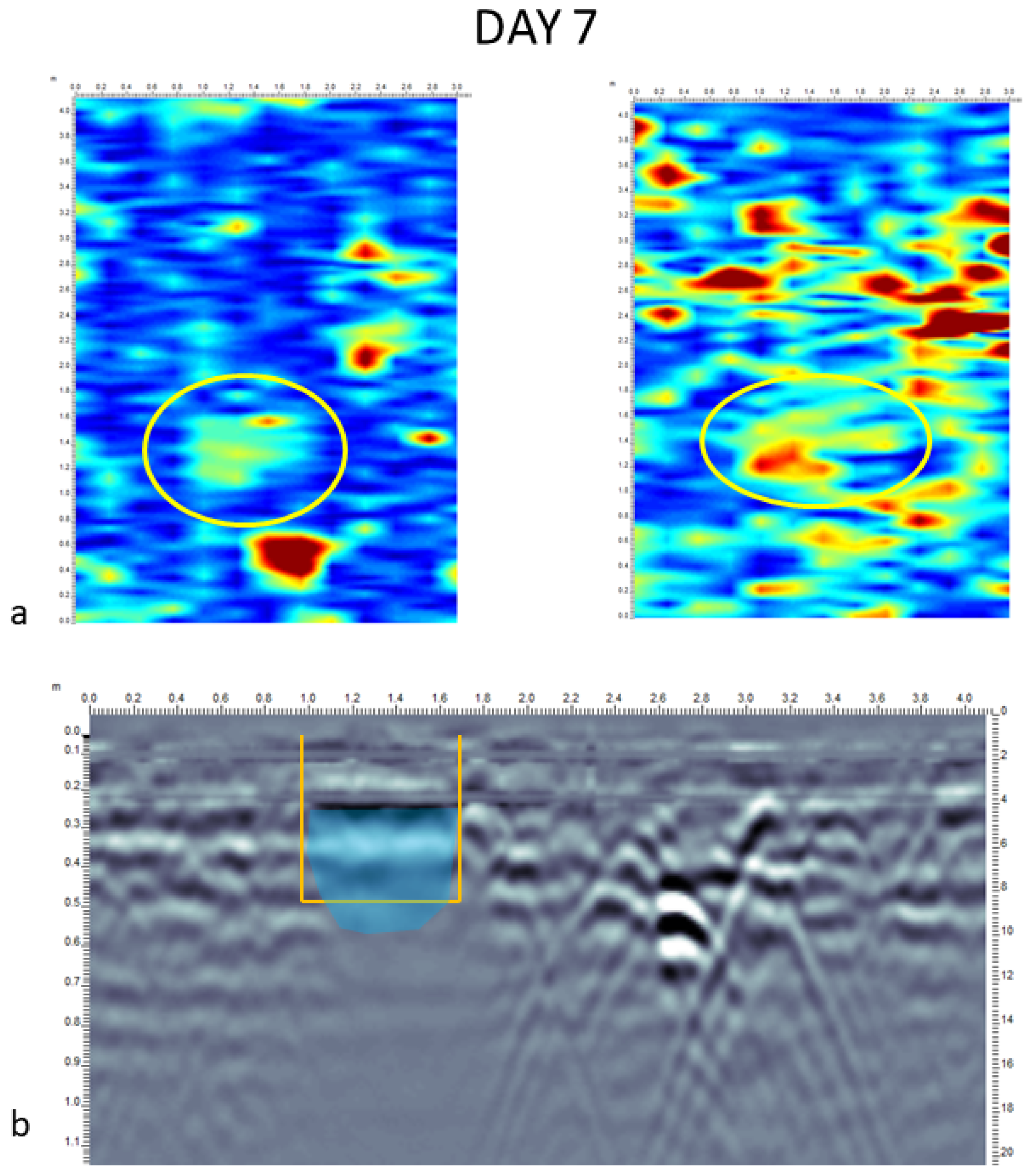
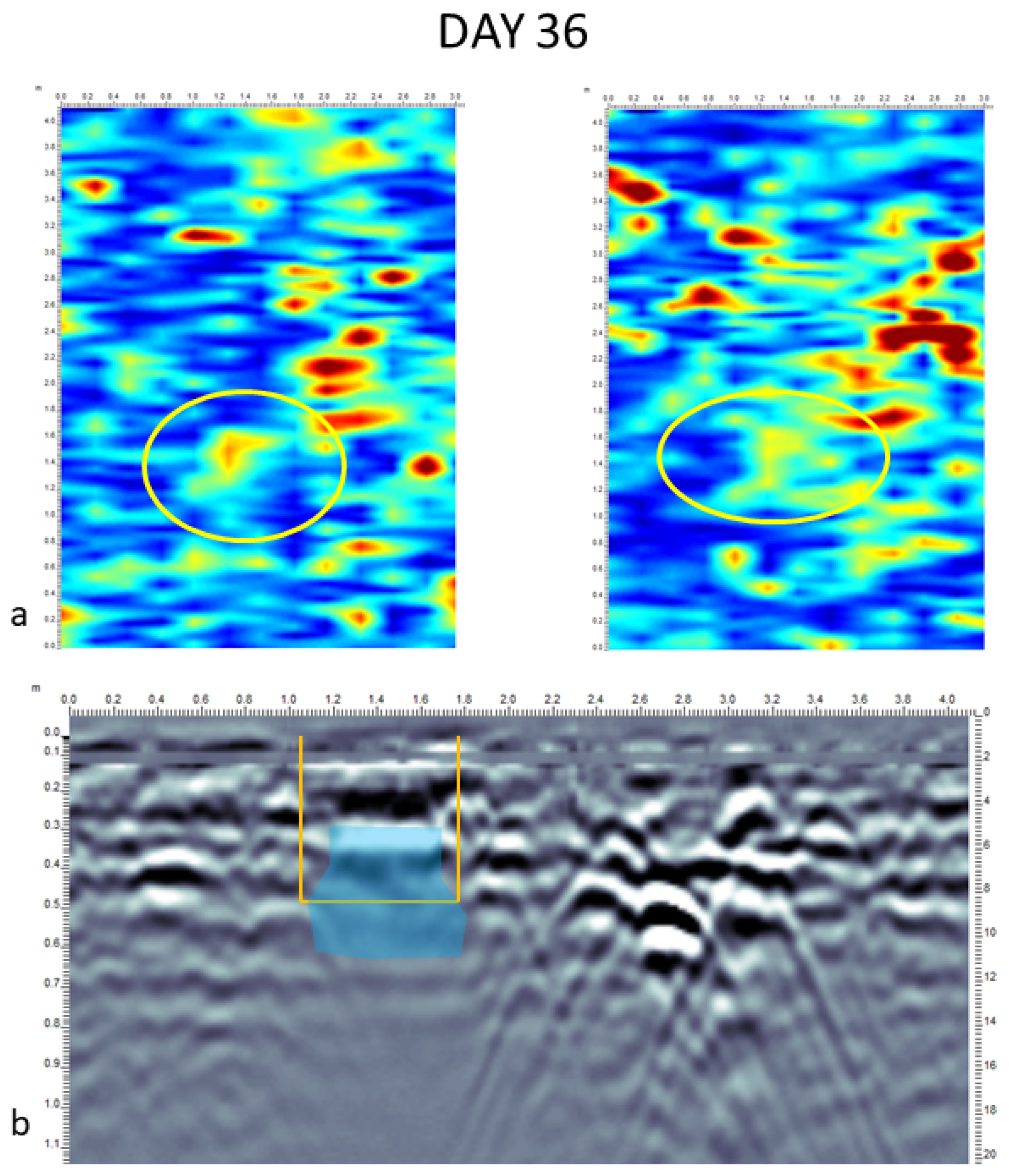
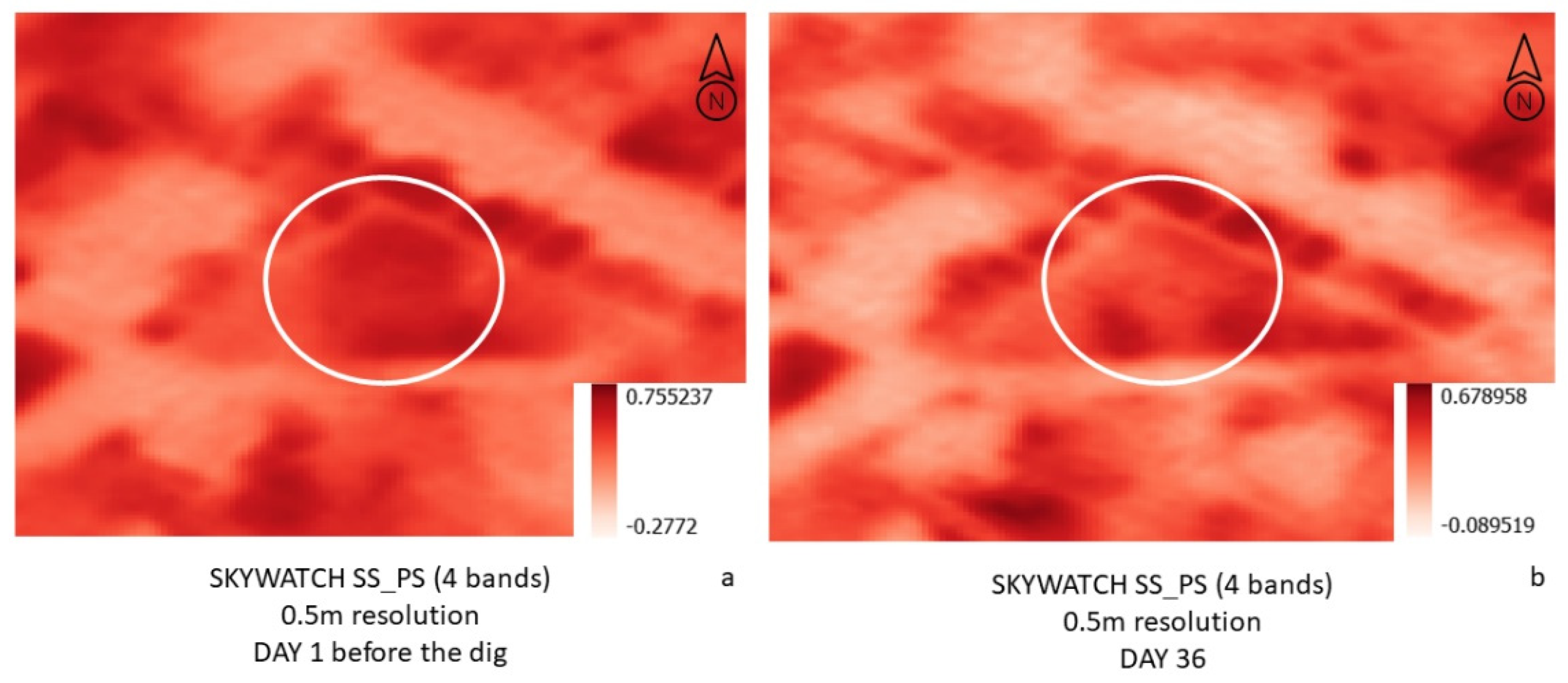
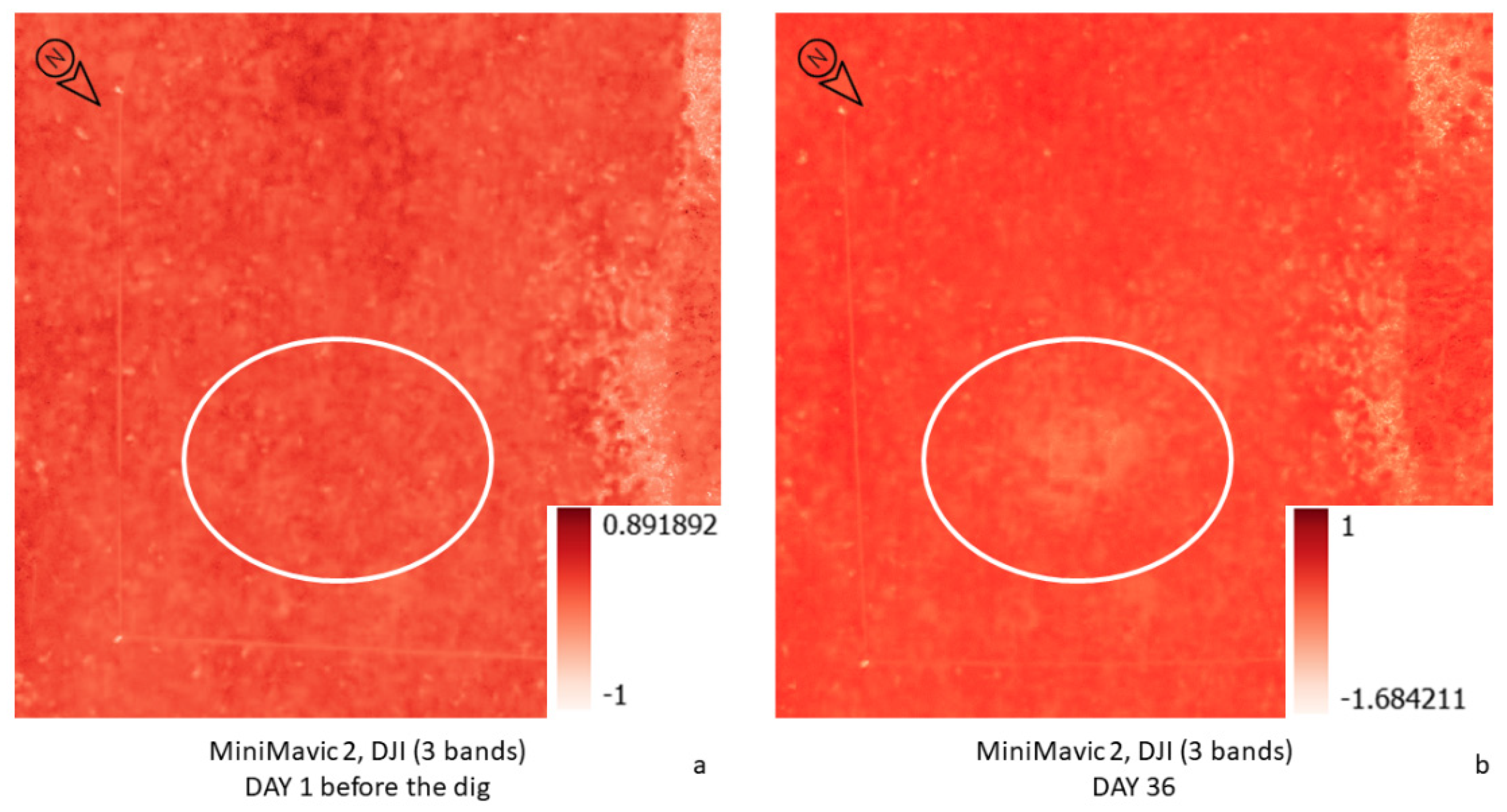
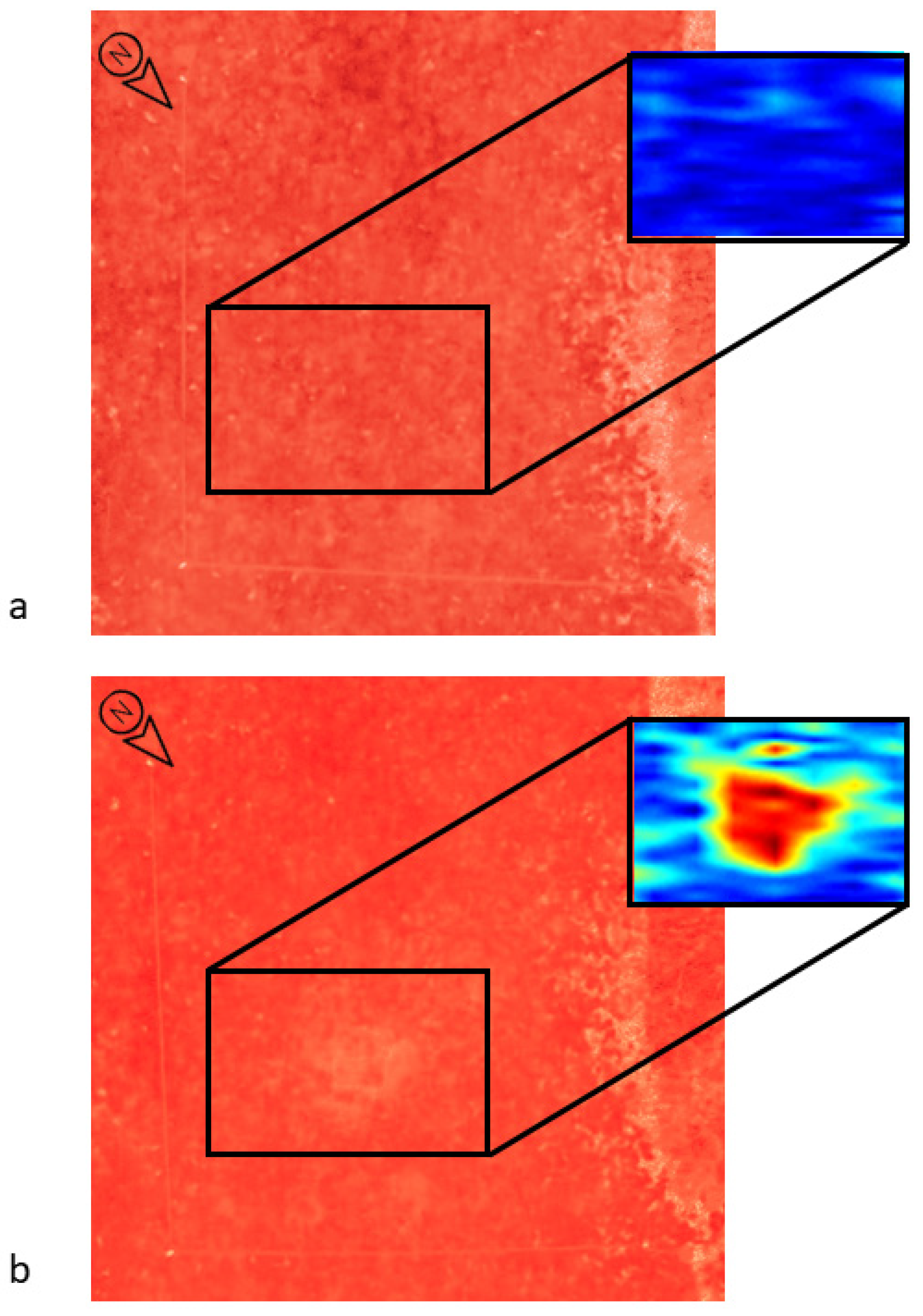
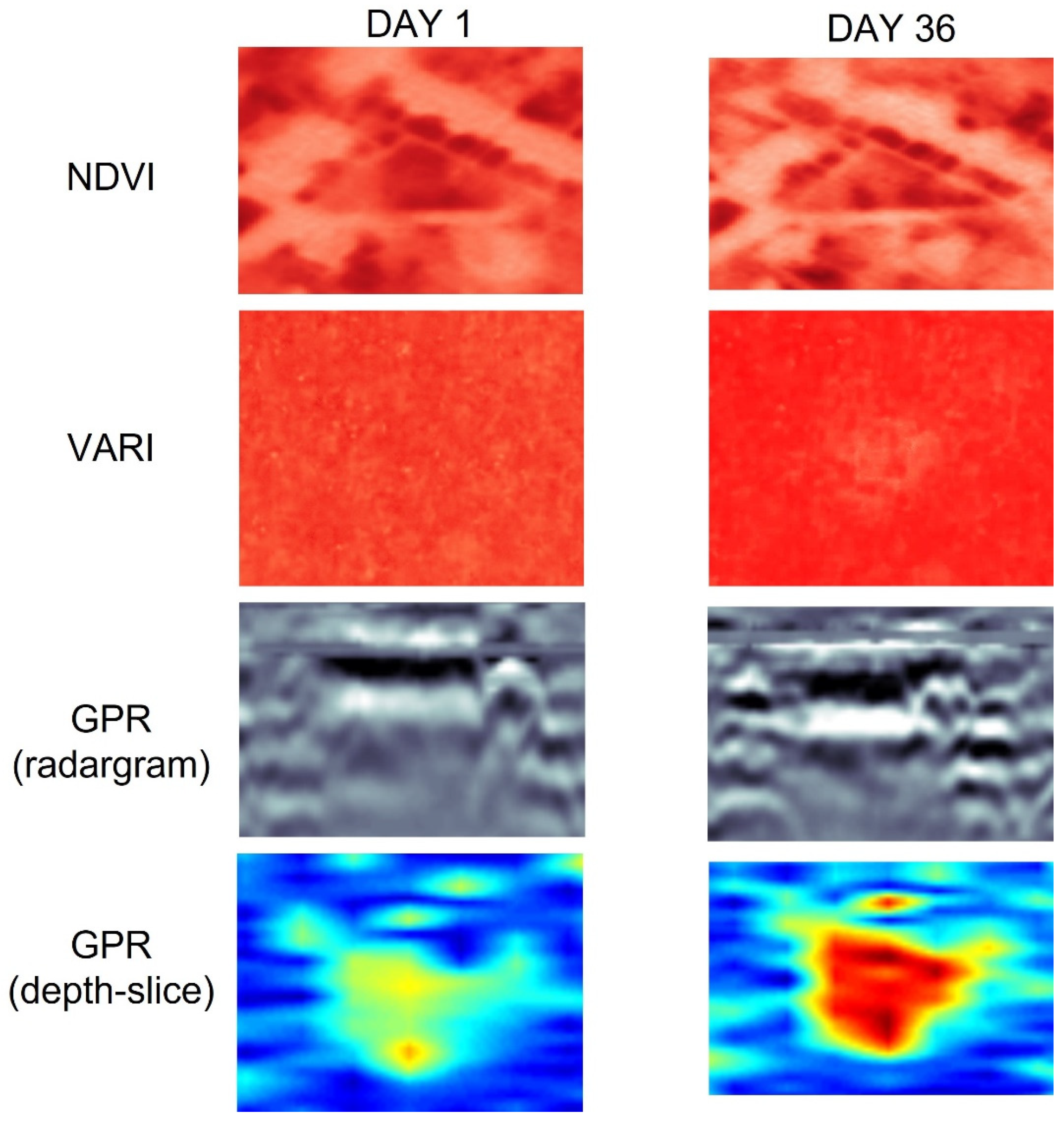
| Day | RS Measurements |
|---|---|
| 1 | Sat 1, UAV, GPR 2 |
| 2 | UAV, GPR |
| 3 | UAV, GPR |
| 4 | UAV, GPR |
| 5 | UAV, GPR |
| 7 | UAV, GPR |
| 36 | Sat, UAV, GPR |
Publisher’s Note: MDPI stays neutral with regard to jurisdictional claims in published maps and institutional affiliations. |
© 2022 by the authors. Licensee MDPI, Basel, Switzerland. This article is an open access article distributed under the terms and conditions of the Creative Commons Attribution (CC BY) license (https://creativecommons.org/licenses/by/4.0/).
Share and Cite
Barone, P.M.; Matsentidi, D.; Mollard, A.; Kulengowska, N.; Mistry, M. Mapping Decomposition: A Preliminary Study of Non-Destructive Detection of Simulated body Fluids in the Shallow Subsurface. Forensic Sci. 2022, 2, 620-634. https://doi.org/10.3390/forensicsci2040046
Barone PM, Matsentidi D, Mollard A, Kulengowska N, Mistry M. Mapping Decomposition: A Preliminary Study of Non-Destructive Detection of Simulated body Fluids in the Shallow Subsurface. Forensic Sciences. 2022; 2(4):620-634. https://doi.org/10.3390/forensicsci2040046
Chicago/Turabian StyleBarone, Pier Matteo, Danielle Matsentidi, Alex Mollard, Nikola Kulengowska, and Mohit Mistry. 2022. "Mapping Decomposition: A Preliminary Study of Non-Destructive Detection of Simulated body Fluids in the Shallow Subsurface" Forensic Sciences 2, no. 4: 620-634. https://doi.org/10.3390/forensicsci2040046
APA StyleBarone, P. M., Matsentidi, D., Mollard, A., Kulengowska, N., & Mistry, M. (2022). Mapping Decomposition: A Preliminary Study of Non-Destructive Detection of Simulated body Fluids in the Shallow Subsurface. Forensic Sciences, 2(4), 620-634. https://doi.org/10.3390/forensicsci2040046







